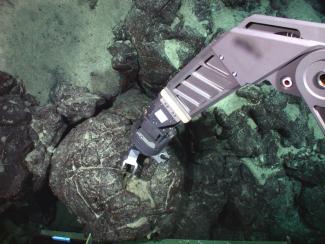Below is a joint UBC and University of Hawaii press release on a paper by Dr. Dominique Weis, Director of PCIGR, and her colleagues, entitled “Role of the deep mantle in generating bilateral the compositional asymmetry of the Hawaiian mantle plume.” The paper was just published in Nature Geoscience.
Lava Fingerprinting Reveals Differences Between Hawaii’s Twin Volcanoes
NOVEMBER 29, 2011
Hawaii’s main volcano chains—the Loa and Kea trends—have distinct sources of magma and unique plumbing systems connecting them to the Earth’s deep mantle, according to UBC research published this week in Nature Geoscience, in conjunction with researchers at the universities of Hawaii and Massachusetts.

This study is the first to conclusively relate geochemical differences in surface lava rocks from both chains to differences in their deep mantle sources, 2,800 kilometres below the Earth’s surface, at the core-mantle boundary.
“We now know that by studying oceanic island lavas we can approach the composition of the Earth’s mantle, which represents 80 per cent of the Earth’s volume and is obviously not directly accessible,” says Dominique Weis, Canada Research Chair in the Geochemistry of the Earth’s Mantle and Director of UBC’s Pacific Centre for Isotopic and Geochemical Research.
“It also implies that mantle plumes indeed bring material from the deep mantle to the surface and are a crucial means of heat and material transport to the surface.”
The results of this study also suggest that a recent dramatic increase in Hawaiian volcanism, as expressed by the existence of the Hawaiian islands and the giant Mauna Loa and Mauna Kea volcanoes (which are higher than Mount Everest when measured from their underwater base) is related to a shift in the composition and structure of the source region of the Hawaiian mantle plume. Thus, this work shows, for the first time, that the chemistry of hotspot lavas is a novel and elegant probe of deep earth evolution.
Weis and UBC colleagues Mark Jellinek and James Scoates made the connection by fingerprinting samples of Hawaiian island lavas–generated over the course of five million years–by isotopic analyses. The research included collecting 120 new samples from Mauna Loa–“the largest volcano on Earth” emphasizes co-author and University of Massachusetts professor Michael Rhodes.
“Hawaiian volcanoes are the best studied in the world and yet we are continuing to make fundamental discoveries about how they work,” according to co-author and University of Hawaii volcanologist Michael Garcia.
The next steps for the researchers will be to study the entire length of the Hawaiian chain (which provides lava samples ranging in age from five to 42 million years old) as well as other key oceanic islands to assess if the two trends can be traced further back in time and to strengthen the relationship between lavas and the composition of the deep mantle.